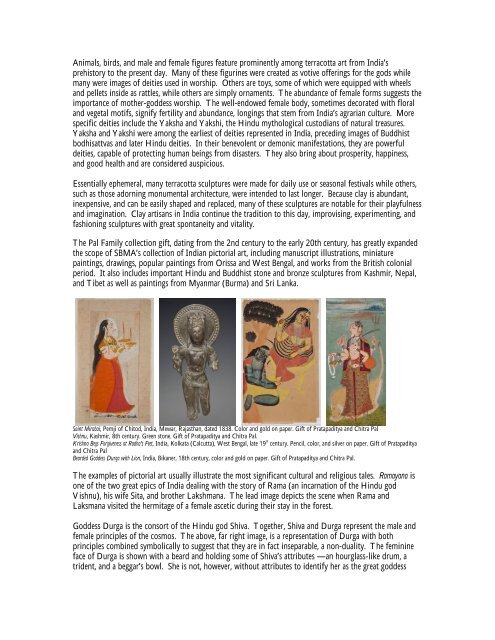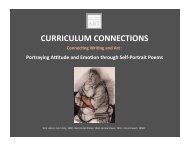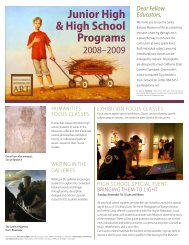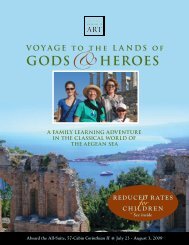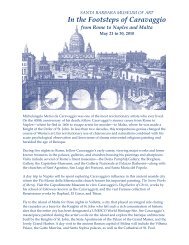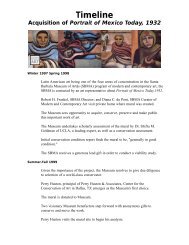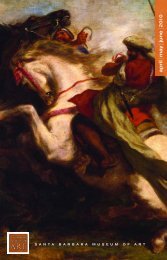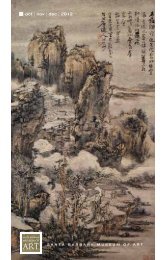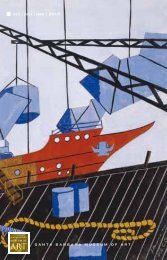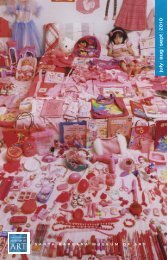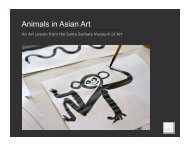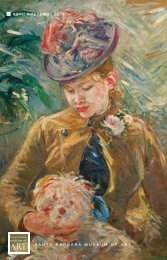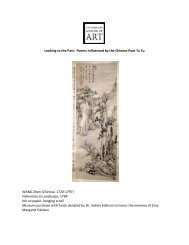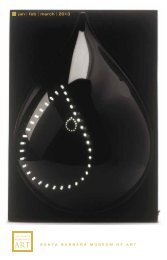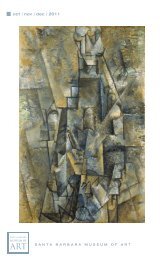From India and Beyond - Santa Barbara Museum of Art
From India and Beyond - Santa Barbara Museum of Art
From India and Beyond - Santa Barbara Museum of Art
You also want an ePaper? Increase the reach of your titles
YUMPU automatically turns print PDFs into web optimized ePapers that Google loves.
Animals, birds, <strong>and</strong> male <strong>and</strong> female figures feature prominently among terracotta art from <strong>India</strong>’s<br />
prehistory to the present day. Many <strong>of</strong> these figurines were created as votive <strong>of</strong>ferings for the gods while<br />
many were images <strong>of</strong> deities used in worship. Others are toys, some <strong>of</strong> which were equipped with wheels<br />
<strong>and</strong> pellets inside as rattles, while others are simply ornaments. The abundance <strong>of</strong> female forms suggests the<br />
importance <strong>of</strong> mother-goddess worship. The well-endowed female body, sometimes decorated with floral<br />
<strong>and</strong> vegetal motifs, signify fertility <strong>and</strong> abundance, longings that stem from <strong>India</strong>’s agrarian culture. More<br />
specific deities include the Yaksha <strong>and</strong> Yakshi, the Hindu mythological custodians <strong>of</strong> natural treasures.<br />
Yaksha <strong>and</strong> Yakshi were among the earliest <strong>of</strong> deities represented in <strong>India</strong>, preceding images <strong>of</strong> Buddhist<br />
bodhisattvas <strong>and</strong> later Hindu deities. In their benevolent or demonic manifestations, they are powerful<br />
deities, capable <strong>of</strong> protecting human beings from disasters. They also bring about prosperity, happiness,<br />
<strong>and</strong> good health <strong>and</strong> are considered auspicious.<br />
Essentially ephemeral, many terracotta sculptures were made for daily use or seasonal festivals while others,<br />
such as those adorning monumental architecture, were intended to last longer. Because clay is abundant,<br />
inexpensive, <strong>and</strong> can be easily shaped <strong>and</strong> replaced, many <strong>of</strong> these sculptures are notable for their playfulness<br />
<strong>and</strong> imagination. Clay artisans in <strong>India</strong> continue the tradition to this day, improvising, experimenting, <strong>and</strong><br />
fashioning sculptures with great spontaneity <strong>and</strong> vitality.<br />
The Pal Family collection gift, dating from the 2nd century to the early 20th century, has greatly exp<strong>and</strong>ed<br />
the scope <strong>of</strong> SBMA’s collection <strong>of</strong> <strong>India</strong>n pictorial art, including manuscript illustrations, miniature<br />
paintings, drawings, popular paintings from Orissa <strong>and</strong> West Bengal, <strong>and</strong> works from the British colonial<br />
period. It also includes important Hindu <strong>and</strong> Buddhist stone <strong>and</strong> bronze sculptures from Kashmir, Nepal,<br />
<strong>and</strong> Tibet as well as paintings from Myanmar (Burma) <strong>and</strong> Sri Lanka.<br />
Saint Mirabai, Pemji <strong>of</strong> Chitod, <strong>India</strong>, Mewar, Rajasthan, dated 1838. Color <strong>and</strong> gold on paper. Gift <strong>of</strong> Pratapaditya <strong>and</strong> Chitra Pal<br />
Vishnu, Kashmir, 8th century. Green stone. Gift <strong>of</strong> Pratapaditya <strong>and</strong> Chitra Pal.<br />
Krishna Begs Forgiveness at Radha’s Feet, <strong>India</strong>, Kolkata (Calcutta), West Bengal, late 19 th century. Pencil, color, <strong>and</strong> silver on paper. Gift <strong>of</strong> Pratapaditya<br />
<strong>and</strong> Chitra Pal<br />
Bearded Goddess Durga with Lion, <strong>India</strong>, Bikaner, 18th century, color <strong>and</strong> gold on paper. Gift <strong>of</strong> Pratapaditya <strong>and</strong> Chitra Pal.<br />
The examples <strong>of</strong> pictorial art usually illustrate the most significant cultural <strong>and</strong> religious tales. Ramayana is<br />
one <strong>of</strong> the two great epics <strong>of</strong> <strong>India</strong> dealing with the story <strong>of</strong> Rama (an incarnation <strong>of</strong> the Hindu god<br />
Vishnu), his wife Sita, <strong>and</strong> brother Lakshmana. The lead image depicts the scene when Rama <strong>and</strong><br />
Laksmana visited the hermitage <strong>of</strong> a female ascetic during their stay in the forest.<br />
Goddess Durga is the consort <strong>of</strong> the Hindu god Shiva. Together, Shiva <strong>and</strong> Durga represent the male <strong>and</strong><br />
female principles <strong>of</strong> the cosmos. The above, far right image, is a representation <strong>of</strong> Durga with both<br />
principles combined symbolically to suggest that they are in fact inseparable, a non-duality. The feminine<br />
face <strong>of</strong> Durga is shown with a beard <strong>and</strong> holding some <strong>of</strong> Shiva’s attributes —an hourglass-like drum, a<br />
trident, <strong>and</strong> a beggar’s bowl. She is not, however, without attributes to identify her as the great goddess


